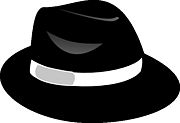Six Thinking Hats
| Line 44: | Line 44: | ||
"What are the facts?" | "What are the facts?" | ||
| + | |||
"What do I know?" | "What do I know?" | ||
| + | |||
"What do I need to know?" | "What do I need to know?" | ||
| + | |||
"How will i get the information I need?" | "How will i get the information I need?" | ||
Revision as of 11:29, 23 February 2018
Contents |
Overview
The Six Thinking Hats is a group thinking exercise developed by Edward de Bono and was published in 1985. The Six Thinking Hats is used to structure and plan thinking processes for ... and is described as parallel thinking, as it encourages exploration and lateral thinking.
Methodology
.... parallel thinking .... differing points of view
.... not the natural way of thinking .... hats are not meant to be worn for lengthy periods of time
Method
Each hat represents a different type of thinking and is worn by each member during group discussions, ensuring all members are able to investigate and explore all points of view in parallel.
Red Hat
The red hat is used to explore the emotional perspective of a project, program or portfolio. Th wearer is usually intuitive and instinctive and will usually rely on their gut reactions, feelings, emotions and instincts for the discussion. The wearer will not provide any justification for their responses and can often be persuaded during the course of the discussion as feelings can change.
Yellow Hat
The yellow hat is used to explore the optimistic persepctive of a project, program or portfolio. The wearer will be optimistic and always thinking about the benefits. Typically the wearer will try to identify the positive aspects of the project/program/portfolio and will provide logical reasoning for them. Yellow hat thinkers are also seeking harmony within the discussion.
Blue Hat
The blue hat is used to explore the managing perspective of a project, program or portfolio. It is used to discuss process control and typically the wearer of the blue hat is trying to organise the thinking and plan for action, they will ask questions, ask for summaries, conslusions and decisions.
Green Hat
The green hat is used to explore the creativity persepctive of a project, program or portfolio. It is used to enable outside the box thinking and typically the wearer will provoke others and i´nvestigate ideas or thóughts. The wearer of the green hat usually comes up with alternatives, ideas and solutions to black hat problems.
White Hat
The white hat is used to explore the facts of a project, program or portfolio. The wearer of the white hat will only use available information in their assessments and discussions and will remain neutral and objective.
Typical questions asked by white hat wearers:
"What are the facts?"
"What do I know?"
"What do I need to know?"
"How will i get the information I need?"
Black Hat
The black hat is used to explore the cautious perspective of a project, program or portfolio. The wearer will typically think of the risks, challenges, obstacles and barriers. The black hat thinker will provide logical reasons for their concerns and is generally conservative, practical and realistic in their reponses.
Application / Uses
With 6 clear and different modes of thinking established, distinct thinking strategies can then be applied to different stages of project, program and portfolio management.
In any parallel thinking process task, the blue hat should start and end the process enabling a clear process of the how to think and organise, the decisions made and the conclusions. Other thinking hats can then be applied in any order and repeated in order depending on particular focus within the project, program or portfolio.
Classical examples set out on Dr De Bono's book include:
Initial Ideas – Blue, White, Green, Blue
Choosing between alternatives – Blue, White,(Green), Yellow, Black, Red, Blue
Identifying Solutions – Blue, White, Black, Green, Blue
Quick Feedback – Blue, Black, Green, Blue
Strategic Planning – Blue, Yellow, Black, White, Blue, Green, Blue
Process Improvement – Blue, White, White (Other peoples views), Yellow, Black, Green, Red, Blue
Solving Problems – Blue, White, Green, Red, Yellow, Black, Green, Blue
Performance Review – Blue, Red, White, Yellow, Black, Green Red, Blue
Benefits
1. Creates awareness of multiple perspectives and points of view
2. Creates a safe space to discuss issues without predjudice
3. Enables mechanisms to switch gears and thinking
4. Promotes focussed thinking
5. Improves communication
6. Improves decision making
7. Improves creativity of solutions





